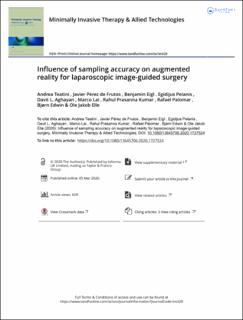| dc.contributor.author | Teatini, Andrea | |
| dc.contributor.author | Perez de Frutos, Javier | |
| dc.contributor.author | Eigl, Benjamin | |
| dc.contributor.author | Aghayan, Davit | |
| dc.contributor.author | Pelanis, Egidijus | |
| dc.contributor.author | Lai, Marco | |
| dc.contributor.author | Kumar, Rahul Prasanna | |
| dc.contributor.author | Palomar, Rafael | |
| dc.contributor.author | Edwin, Bjørn | |
| dc.contributor.author | Elle, Ole Jacob | |
| dc.date.accessioned | 2021-03-19T11:36:51Z | |
| dc.date.available | 2021-03-19T11:36:51Z | |
| dc.date.created | 2021-01-25T13:11:01Z | |
| dc.date.issued | 2020 | |
| dc.identifier.citation | MITAT. Minimally invasive therapy & allied technologies. 2020, 1-10. | en_US |
| dc.identifier.issn | 1364-5706 | |
| dc.identifier.uri | https://hdl.handle.net/11250/2734456 | |
| dc.description.abstract | Purpose
This study aims to evaluate the accuracy of point-based registration (PBR) when used for augmented reality (AR) in laparoscopic liver resection surgery.
Material and methods
The study was conducted in three different scenarios in which the accuracy of sampling targets for PBR decreases: using an assessment phantom with machined divot holes, a patient-specific liver phantom with markers visible in computed tomography (CT) scans and in vivo, relying on the surgeon’s anatomical understanding to perform annotations. Target registration error (TRE) and fiducial registration error (FRE) were computed using five randomly selected positions for image-to-patient registration.
Results
AR with intra-operative CT scanning showed a mean TRE of 6.9 mm for the machined phantom, 7.9 mm for the patient-specific phantom and 13.4 mm in the in vivo study.
Conclusions
AR showed an increase in both TRE and FRE throughout the experimental studies, proving that AR is not robust to the sampling accuracy of the targets used to compute image-to-patient registration. Moreover, an influence of the size of the volume to be register was observed. Hence, it is advisable to reduce both errors due to annotations and the size of registration volumes, which can cause large errors in AR systems. | en_US |
| dc.language.iso | eng | en_US |
| dc.publisher | Taylor & Francis | en_US |
| dc.rights | Attribution-NonCommercial-NoDerivatives 4.0 Internasjonal | * |
| dc.rights.uri | http://creativecommons.org/licenses/by-nc-nd/4.0/deed.no | * |
| dc.title | Influence of sampling accuracy on augmented reality for laparoscopic image-guided surgery | en_US |
| dc.type | Peer reviewed | en_US |
| dc.type | Journal article | en_US |
| dc.description.version | publishedVersion | en_US |
| dc.source.pagenumber | 1-10 | en_US |
| dc.source.journal | MITAT. Minimally invasive therapy & allied technologies | en_US |
| dc.identifier.doi | 10.1080/13645706.2020.1727524 | |
| dc.identifier.cristin | 1878411 | |
| cristin.ispublished | true | |
| cristin.fulltext | original | |
| cristin.qualitycode | 1 | |

